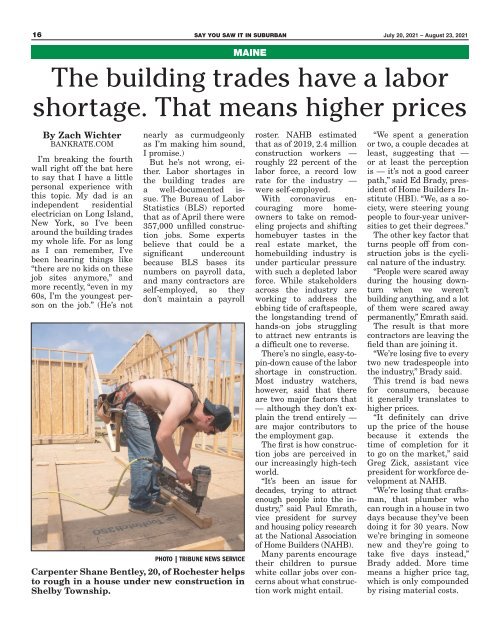Create successful ePaper yourself
Turn your PDF publications into a flip-book with our unique Google optimized e-Paper software.
16 SAY YOU SAW IT IN SUBURBAN July 20, 2021 – August 23, 2021<br />
By Zach Wichter<br />
BANKRATE.COM<br />
I’m breaking the fourth<br />
wall right off the bat here<br />
to say that I have a little<br />
personal experience with<br />
this topic. My dad is an<br />
independent residential<br />
electrician on Long Island,<br />
New York, so I’ve been<br />
around the building trades<br />
my whole life. For as long<br />
as I can remember, I’ve<br />
been hearing things like<br />
“there are no kids on these<br />
job sites anymore,” and<br />
more recently, “even in my<br />
60s, I’m the youngest person<br />
on the job.” (He’s not<br />
nearly as curmudgeonly<br />
as I’m making him sound,<br />
I promise.)<br />
But he’s not wrong, either.<br />
Labor shortages in<br />
the building trades are<br />
a well-documented issue.<br />
The Bureau of Labor<br />
Statistics (BLS) reported<br />
that as of April there were<br />
357,000 unfilled construction<br />
jobs. Some experts<br />
believe that could be a<br />
significant undercount<br />
because BLS bases its<br />
numbers on payroll data,<br />
and many contractors are<br />
self-employed, so they<br />
don’t maintain a payroll<br />
MAINE<br />
The building trades have a labor<br />
shortage. That means higher prices<br />
PHOTO | TRIBUNE NEWS SERVICE<br />
Carpenter Shane Bentley, 20, of Rochester helps<br />
to rough in a house under new construction in<br />
Shelby Township.<br />
roster. NAHB estimated<br />
that as of 2019, 2.4 million<br />
construction workers —<br />
roughly 22 percent of the<br />
labor force, a record low<br />
rate for the industry —<br />
were self-employed.<br />
With coronavirus encouraging<br />
more homeowners<br />
to take on remodeling<br />
projects and shifting<br />
homebuyer tastes in the<br />
real estate market, the<br />
homebuilding industry is<br />
under particular pressure<br />
with such a depleted labor<br />
force. While stakeholders<br />
across the industry are<br />
working to address the<br />
ebbing tide of craftspeople,<br />
the longstanding trend of<br />
hands-on jobs struggling<br />
to attract new entrants is<br />
a difficult one to reverse.<br />
There’s no single, easy-topin-down<br />
cause of the labor<br />
shortage in construction.<br />
Most industry watchers,<br />
however, said that there<br />
are two major factors that<br />
— although they don’t explain<br />
the trend entirely —<br />
are major contributors to<br />
the employment gap.<br />
The first is how construction<br />
jobs are perceived in<br />
our increasingly high-tech<br />
world.<br />
“It’s been an issue for<br />
decades, trying to attract<br />
enough people into the industry,”<br />
said Paul Emrath,<br />
vice president for survey<br />
and housing policy research<br />
at the National Association<br />
of Home Builders (NAHB).<br />
Many parents encourage<br />
their children to pursue<br />
white collar jobs over concerns<br />
about what construction<br />
work might entail.<br />
“We spent a generation<br />
or two, a couple decades at<br />
least, suggesting that —<br />
or at least the perception<br />
is — it’s not a good career<br />
path,” said Ed Brady, president<br />
of Home Builders Institute<br />
(HBI). “We, as a society,<br />
were steering young<br />
people to four-year universities<br />
to get their degrees.”<br />
The other key factor that<br />
turns people off from construction<br />
jobs is the cyclical<br />
nature of the industry.<br />
“People were scared away<br />
during the housing downturn<br />
when we weren’t<br />
building anything, and a lot<br />
of them were scared away<br />
permanently,” Emrath said.<br />
The result is that more<br />
contractors are leaving the<br />
field than are joining it.<br />
“We’re losing five to every<br />
two new tradespeople into<br />
the industry,” Brady said.<br />
This trend is bad news<br />
for consumers, because<br />
it generally translates to<br />
higher prices.<br />
“It definitely can drive<br />
up the price of the house<br />
because it extends the<br />
time of completion for it<br />
to go on the market,” said<br />
Greg Zick, assistant vice<br />
president for workforce development<br />
at NAHB.<br />
“We’re losing that craftsman,<br />
that plumber who<br />
can rough in a house in two<br />
days because they’ve been<br />
doing it for 30 years. Now<br />
we’re bringing in someone<br />
new and they’re going to<br />
take five days instead,”<br />
Brady added. More time<br />
means a higher price tag,<br />
which is only compounded<br />
by rising material costs.

















